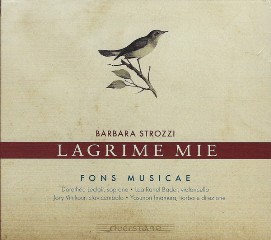Barbara Strozzi - Lagrime Mie (2014)
Barbara Strozzi - Lagrime Mie (2014)

1 Barbara Strozzi Lagrime mie (Op. 7) 8:52 2 Barbara Strozzi Se volete cosi me ne contento (Op. 6) 4:51 3 Alessandro Piccinini Toccata XII (tiorba sola) 2:45 4 Alessandro Piccinini Corrente V (tiorba sola) 1:38 5 Barbara Strozzi Che v'hò fato (Op. 7) 7:59 6 Bernardo Storace Ciaccona (clavicembalo solo) 5:56 7 Barbara Strozzi Chiudi l'audaci labra (Op. 6) 6:26 8 Girolamo Frescobaldi Canzon Prima (violoncello solo) 4:29 9 Barbara Strozzi L'Eraclito Amoroso "Udite Amanti" (Op. 2) 5:51 10 Barbara Strozzi Lilla mia, non to doler (Op. 6) 2:09 11 Giovanni Girolamo Kapsberger Canzona I (tiorba sola) 3:44 12 Giovanni Girolamo Kapsberger Canario (tiorba sola) 2:06 13 Barbara Strozzi Che si può fare? 9:02 Fons Musicae - ensemble Dorothée Leclair -soprano Lea Rahel Bader - cello Yasunori Imamura - theorbo Jory Vinikour - harpsichord Iasunori Imamura - director
Barbara Strozzi is one of the most remarkable composers of the 17th century. That is not because she was a woman: there were more women who were active as composers and even published their compositions. But almost all of them were residents of a convent and composed sacred music which they wrote first and foremost for liturgical use in their own convent. Barbara Strozzi's oeuvre almost exclusively comprises secular music. She was also active as a singer, although in private circles, not in public concerts and not on the stage, for instance in an opera.
That said, her oeuvre is highly dramatic in character. That is certainly due to the fact that she was educated in composition by Francesco Cavalli who would become the most famous Venetian opera composer after the death of Monteverdi. Her father, Giulio, had also strong ties with opera: he was a poet who wrote a large number of opera librettos which were set by the main composers of his time. He was also largely responsible for Barbara's career. He founded the Accademia degli Unisoni, a kind of literary academy which gave her the chance to perform, certainly mostly her own compositions, and to listen to the deliberations of its members, especially about artistic matters.
Strozzi published her first collection of music in 1644: madrigals for two to five voices and basso continuo. It was followed by seven books of pieces, mostly for solo voice and basso continuo. The first was the op. 2 which appeared in 1651 and the last the op. 8 which dates from 1664. Only one of these books comprised sacred works: the op. 5 of 1655. Most of the texts were written specifically for her; about half of them are anonymous.
Strozzi was very much concerned about the form of her compositions, which were called arie, ariette or cantate. She sometimes took strophic poems but often treated them with considerable freedom, probably driven by the wish to translate the affetti of the text as accurately and effectively as possible. In free texts - mostly divided into a number of sections of different length and character - Strozzi tries to create some formal unity by repeating lines or sections. An example of such a piece is Lagrime mie which opens with the lines: "Oh my tears, why do you not fall? Why do you not release the cruel pain which steals my breath and burdens my heart?" This is repeated at the end, and halfway the first of these lines is inserted. This way it works like a kind of refrain.
Strozzi uses various devices to express the emotions in the text and to create dramatic contrasts. One of these is a remarkable range of the solo part, which attests to her own skills as a singer. Others are shifts in meter and tempo, contrasts between measured and unmeasured passages as well as the juxtaposition of episodes in a purely monodic style - à la Caccini - and more lyrical passages, such as we find them in the operas of Cavalli.
Strozzi is an important link in the chain from Caccini - the first decade of the 17th century - to Alessandro Scarlatti who - towards the end of the century - set the standard for the texture of the chamber cantata with its sequence of recitatives and arias. In several of Strozzi's works we find recitativic passages which point to the future, for instance in Che di può fare. Vocal chamber music as a pocket-size opera - that was the character of the chamber cantata in the early 18th century, and in Lagrime mie we find the unmistakable traces of that.
Barbara Strozzi is fairly well represented on disc. Although I don't know every recording of her oeuvre, it seems that this disc includes various pieces which are not recorded before or at least seldom performed. Lagrime mie and L'Eraclito amoroso are the best-known items in the present programme. Over the years I have heard several recordings of Fons Musicae. Its soprano used to be Monique Zanetti who certainly didn't lack dramatic skills but whose often incessant vibrato seriously damaged the quality of the ensemble's performances. Now her place has been taken by Dorothée Leclair, and as a dramatic interpreter she is Ms Zanetti's equal. Unfortunately little has changed in the vibrato department, although there are many passages where she sings without. I find its application rather inconsistent. I have really no idea why it is used in some passages and is omitted elsewhere. It is certainly not used only as an ornament. From that angle this disc is not unproblematic.
However, the interpretation is first-class: the contrasts within these pieces is impressively conveyed, and the instrumentalists support Ms Leclair in theatrical fashion, setting strong dynamic and rhythmic accents where it is due. Those who have a special interest in this repertoire should definitely investigate it, especially as some of the items are rarely heard. ---Johan van Veen, musica-dei-donum.org
download (mp3 @320 kbs):
yandex mediafire ulozto solidfiles workupload








